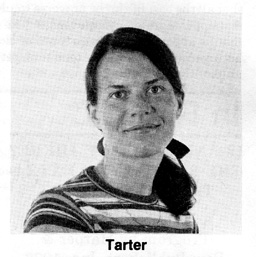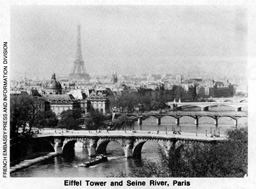
Paris was enchanting, the U.N.E.S.C.O. aides were extraordinarily helpful, the multi-lingual translation services were faultless and as long as the speeches were social or political, everything went smoothly. However, when the scientists attending this conference attempted to address the technical matters which had drawn them together, it was a different story! The audiovisual facilities were hopeless even when they were finally installed. (One slide projector consumed half its weight in plastic framed slides before the meeting ended!)
 Perhaps the most exciting aspect of participation in a conference on "Life in the Universe" is the potential for cross disciplinary exchange; radio astronomers talking with geologists or paleobiologists and chemists arguing points with climatologists—sadly, the opening and closing ceremonies and a fraction of the first morning session were the only opportunities for all the participants to interact. The main body of the scientific sessions ran in parallel precluding the possibility of cross fertilization. The necessity of parallel sessions is a frequent complaint of many meetings, but on this
particular subject, the segregation of different disciplines is self-defeating; next time I'll stay home!
Perhaps the most exciting aspect of participation in a conference on "Life in the Universe" is the potential for cross disciplinary exchange; radio astronomers talking with geologists or paleobiologists and chemists arguing points with climatologists—sadly, the opening and closing ceremonies and a fraction of the first morning session were the only opportunities for all the participants to interact. The main body of the scientific sessions ran in parallel precluding the possibility of cross fertilization. The necessity of parallel sessions is a frequent complaint of many meetings, but on this
particular subject, the segregation of different disciplines is self-defeating; next time I'll stay home!
I do not know what the attendance was at the other two sessions (one on the topic of Planetary Evolution and one on the Origin and Evolution of Life) but I do know that at our session devoted to the Evolution of Intelligence and the Search for Extraterrestrial Intelligence, there were at times only six people in the audience in addition to the speakers! What a shame that the other participants and the local scientific community missed an opportunity to hear and debate the many excellent talks in this session, which was chaired by Frank Drake of Cornell University (and Project Ozma fame).
Cyril Ponnamperuma from the University of Maryland presented several discussions on chemical and pre-biotic evolution on Earth and our attempts to study exobiology elsewhere in the Solar System.
Dale Russell from the National Museum of Canada in Ottawa presented data on the rate of increase in brain-to-body weight ratio over geologic time scales as one indication of the increase in intelligence in terrestrial species.
Bernard Campbell from the L.S.B. Leaky Foundation in Pasadena, California then cataloged the use of tools by animals and hominid species and the development of technology by early man. I spoke about attempts to detect evidence of such technology elsewhere in our Galaxy by summarizing the details of all the SETI searches reported over the past 20 years.
I was also able to compare previous efforts with a specific proposal to NASA for conducting a systematic SETI with existing radio telescopes over the next decade.
Pierre Connes from the CNRS in Paris presented some rationale in favor of an optical SETI and then gave a brief discussion of various promising schemes for detecting extrasolar planets. The capability of detecting Jupiters around nearby stars will exist from the ground and perhaps from the Space Telescope within the decade, however the detection of Earthlike planets by direct or indirect methods requires another generation of space instrumentation.
George Gatewood from the Allegheny Observatory in Pittsburgh then described the photoelectric instrumentation being developed by his group, which allows ground based astrometric observations to achieve milli-arc second precision in minutes rather than in years as has historically been the case.
The session closed with Francois Biraud of Meudon Observatory in France urging the scientific/SETI community to search for some set of orthogonal functions which would describe a waveform which remained completely invariant during traversal of the interstellar medium (a sine wave remains a sine wave, but its frequency can be shifted in transit). Such waveforms, he argued, would be the obvious choice for interstellar communication between civilizations.
As none of us could divine such a waveform, the meeting was adjourned and we went in search of the Beaujolais Nouveau which had arrived in Paris that day. This search, in contrast to some other SETI efforts, was hugely successful! [The "Beaujolais Nouveau" is this year's bottling of local Beaujolais wine, literally "the new Beaujolais".]
 Jill Tarter received a bachelor's degree in engineering-physics (1965) from Cornell University and a master's and doctor's degree in astrophysics (1975) from the University of California, Berkeley. From 1975 to 1977 she held a post-doctoral National Research Council fellowship at NASA-Ames Research Center and since 1977 Dr. Tarter has been Research Assistant for the University of California Berkeley Space Science Laboratory on contract to NASA-Ames Research to do SETI work.
Jill Tarter received a bachelor's degree in engineering-physics (1965) from Cornell University and a master's and doctor's degree in astrophysics (1975) from the University of California, Berkeley. From 1975 to 1977 she held a post-doctoral National Research Council fellowship at NASA-Ames Research Center and since 1977 Dr. Tarter has been Research Assistant for the University of California Berkeley Space Science Laboratory on contract to NASA-Ames Research to do SETI work.
![[NAAPO Logo]](../../Images/NAAPOsm.jpg)
![[NAAPO Logo]](../../Images/NAAPOsm.jpg)